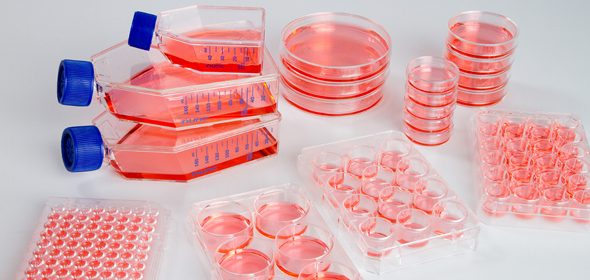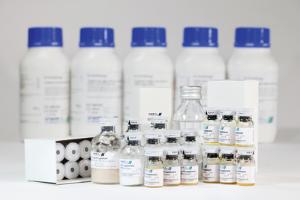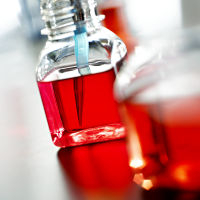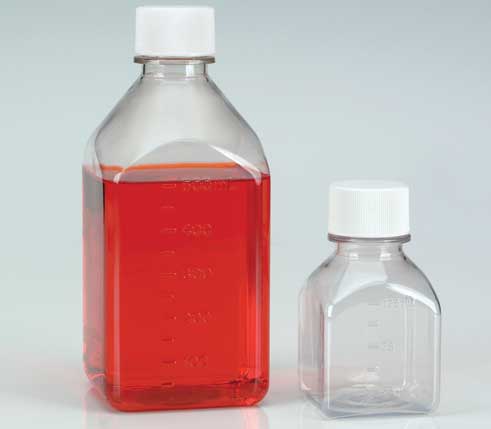Cell Culture Medium
Cell culture is one of the major techniques in the life sciences. It is the general term used for removing cells, tissues or organs from animals or plants and their subsequent placement into an artificial environment conducive to their survival and proliferation. The basic environmental requirements for optimal cell growth are: controlled temperature, appropriate growth medium, correct pH and osmolality, as well as a substrate for cell attachment. The most important and critical step in cell culture is to select appropriate growth medium. Growth medium or culture medium is a liquid or gel designed to support the growth of microorganisms, cells or small plants, which available either as a powder or as a liquid form from commercial suppliers.
Basic Components of Culture Medium
A typical culture medium is composed of glucose, amino acids, vitamins, inorganic salts, serum, hormones, and attachment factors. The requirements for these components vary among cell lines, and these differences are partly responsible for the extensive number of medium formulations. Each component performs a specific function, as described below:
- Buffering systems

Regulating pH is critical for optimum culture conditions and is typically achieved by one of the two buffering systems: 1) Natural buffering system, in a natural buffering system, gaseous CO2 balances with the CO3/HCO3 content of the culture medium. Natural buffering system is low-cost and non-toxic. 2) HEPES, chemical buffering using a zwitterion, HEPES, has a superior buffering capacity in pH range 7.2-7.4 and does not require a controlled gaseous atmosphere. HEPES is relatively expensive and toxic at a higher concentration for certain cell types.
- Phenol red
During the cell growth, medium changes color as pH is changed due to the metabolites released by the cells. Most of the commercially available culture media contain phenol red as a pH indicator to continuously monitor the pH. However, there are certain disadvantages of using phenol red: 1) Phenol red mimics the action of some steroid hormones, particularly estrogen. Thus it is recommended to use phenol red-free medium for the study of estrogen-sensitive cells like mammary tissue. 2) Presence of phenol red in some serum-free formulations interferes with the sodium-potassium balance. This effect can be neutralized by adding serum or bovine pituitary hormone to the medium. 3) Phenol red interferes with detection in flow cytometry studies.
- Inorganic salt
Inorganic salts in the medium help to maintain the osmotic balance and regulate membrane potential by providing sodium, potassium, and calcium ions.
- Amino acids
Amino acids are obligatory ingredients of all known cell culture medium. Essential amino acids must be included as cell cannot synthesize these by themselves. They are essential for cell proliferation and their concentration determines the maximum achievable cell density. Non-essential amino acids can also be added to the medium to replace those that have been depleted during growth. Supplementation of non-essential amino acids stimulates growth and prolongs the viability of the cells.
- Carbohydrates

Carbohydrates in the form of sugar are the major source of energy. Most of the media contain glucose and galactose, however, some contain maltose and fructose.
- Proteins and peptides
The most commonly used proteins and peptides are albumin, transferrin, and fibronectin. They are particularly important in serum-free media. The binding capacity of albumin makes it a suitable remover of toxic substances from cell culture medium. Fibronectin plays a key role in cell attachment. Transferrin is an iron transporter that acts to supply iron to the cell membrane.
- Fatty acids and lipids
They are particularly important in serum-free media as they are generally present in serum.
- Vitamins
Many vitamins are essential for cell growth and proliferation. Vitamins cannot be synthesized in sufficient quantities by cells and are therefore important supplements for tissue culture. The B group vitamins are most commonly used to stimulate growth.
- Trace elements
Trace elements are often supplemented to serum-free media to replace those commonly found in serum. These micronutrients are essential for many biological processes, such as maintaining the functionality of enzymes.
Medium Supplements
The complete growth medium recommended for certain cell lines requires additional components which are not present in the basal medium and serum. These components, supplements, help sustain proliferation and maintain normal cell metabolism.
- Antibiotics
Although not required for cell growth, antibiotics are often used to control the growth of bacterial and fungal contaminants. Conventional use of antibiotics for cell culture is not recommended since antibiotics can mask the contamination by mycoplasma and resistant bacteria. In addition, antibiotics can also interfere with the metabolism of sensitive cells.
- Serum in Medium
Serum is a complex mixture of albumins, growth factors and growth inhibitors. Serum is one of the most important components in cell culture medium and serves as a source for amino acids, proteins, vitamins, carbohydrates, lipids, hormones, growth factors, minerals, and trace elements. Serum extracted from fetal and calf bovine is commonly used to support the growth of cells.
The role of serum in cell culture is very complicated by the presence of both growth factors and inhibitors. In addition to serving various functions, serum has several drawbacks in tissue culture applications.

Table 2. The advantages and disadvantages of serum in the medium.
| Advantages | Disadvantages |
| Serum contains various growth factors and hormones which stimulates cell growth and functions | Testing needs to be done to maintain the quality of each batch before using |
| Helps in the attachment of cells | Increase the risk of contamination |
| Acts as a buffering agent which helps in maintaining the pH of the culture medium | May contain some of the growth inhibiting factors |
| Functions as a binding protein | Lack of uniformity in the composition of serum |
| Minimizes mechanical damages or damages caused by viscosity | Presence of serum in medium may interfere with the purification and isolation of cell culture products |
Classic Cell Culture Medium
Cultured cells require a source of nutrition, typically provided by the classical cell culture medium. This medium is mostly used with a serum supplement.
- Eagle’s minimum essential medium (EMEM)
EMEM was one of the first widely used media to be formulated by Harry Eagle from a simpler basal medium (BME). EMEM contains balanced salt solution, non-essential amino acids, and sodium pyruvate. Since EMEM is a non-complex medium, it is generally reinforced with additional supplements or higher levels of serum, making it suitable for a wide range of mammalian cells.
- Dulbecco’s modified Eagle’s medium (DMEM)
DMEM has almost twice the concentration of amino acids and four times the amount of vitamins as EMEM, as well as ferric nitrate, sodium pyruvate, and some supplementary amino acids. DMEM is a basal medium that contains no proteins or growth promoting agents. Therefore, it requires supplementation to be a “complete” medium. It is most commonly supplemented with 5-10% Fetal Bovine Serum (FBS).
- RPMI-1640
RPMI-1640 is a general purpose medium with a broad range of applications for mammalian cells, especially hematopoietic cells. RPMI-1640 is a modification of McCoy’s 5A and was developed for the long-term culture of peripheral blood lymphocytes. RPMI-1640 uses a bicarbonate buffering system that differs from the most mammalian cell culture media in its typical pH 8 formulation. RPMI-1640 supports the growth of a wide variety of cells in suspension and grown as monolayers.

- DMEM/F12
DMEM/F12 is a mixture of DMEM and Ham’s F-12 and is an extremely rich and complex medium. It supports the growth of a broad range of cell types in both serum and serum-free formulations. HEPES buffer is included in the formulation at a final concentration of 15 mM to compensate for the loss of buffering capacity incurred by eliminating serum.
- Iscove’s modified Dulbecco’s medium (IMDM)
IMDM is a highly enriched synthetic medium well suited for rapidly proliferating, high-density cell cultures. IMDM is a modification of DMEM containing selenium, and has additional amino acids, vitamins and inorganic salts as compared to DMEM. It has potassium nitrate instead of ferric nitrate and also contains HEPES and sodium pyruvate. It was formulated for the growth of lymphocytes and hybridomas.